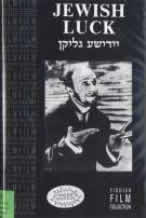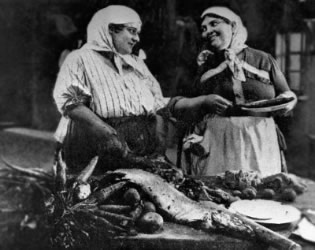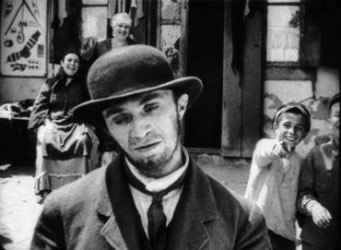JEWISH LUCK
["Yidishe
Glikn", directed by Aleksey Granovsky (1925)]
TITLE:
JEWISH LUCK
YEAR: 1925
DIR/PROD: Alexander Granovsky
COUNTRY: Russia
LANGUAGE: SILENT
TIME: 90 minutes in black and white 35mm
SOURCE: National Center for Jewish Film at brandeis NCJF@Brandeis.edu
 |
 |
This
classic of Soviet cinema is a very funny adaptation of Sholom Aleichem’s
story, “Mendel the Matchmaker.” It is also the film debut of the
great Yiddish State Art Theatre actor, Solomon Mikhoels, who was considered
the greatest living Yiddish actor of his time. Mikhoel’s character study
of Mendel as a Chaplinesque figure – lovable, tragic and comic –
has been called one of the finest performances in cinema history. Mendel is
a luftmensch (one who buys and sells dreams) who, by chance, becomes a matchmaker
and experiences one hilarious calamity after another. This film features a
luminous dream sequence on the Odessa Steps that became the inspiration for
the famous scene in Sergei Eisenstein’s POTEMKIN, which was shot on
the same location. Both films were photographed by Eduard Tisse. Following
the success of last year’s THE GOLEM, with music by Daniel Hoffman,
we have invited back this Bay Area musician and composer. He performs JEWISH
LUCK with the San Francisco Klezmer Experience (Ben Goldberg, clarinets; Daniel
Hoffman, violin; Jeanette Lewicki, accordion; Kevin Mummey, drums; Stephen
Saxon, trumpets, alto horn; Richard Saunders, bass; Charlie Seavey, trombone).
With modern sensibilities, virtuoso musicianship and a great sense of humor,
the SFKE celebrates the wild and passionate essence of klezmer, performed
with daring, panache and abandon. The SFKE was created by violinist Daniel
Hoffman for the American Conservatory Theater's 1996 production of the hit
klezmer musical, "Shlemiel The First," and boasts an all-star roster
of the Bay Area's nationally recognized and innovative klezmer musicians.
Shot mainly in exterior, JEWISH LUCK is almost semi-documentary in its representation of a tumbledown section of Berdichev, the Ukraine's archetypal Jewish town, the production design is virtually ethnographic. Although JEWISH LUCK is ostensibly a portrait of pre-October misery, much of it is underscored by a preservationist spirit. Religious rituals may be conspicuously absent, but the lengthy open-air wedding that ends the film is a veritable précis of the traditional elements that had inspired Chagall's murals.
JEWISH LUCK had the authority of a folk tradition and the weight of official sanction. No subsequent Soviet movie would cast so sympathetic an eye on the culture of the shtetl - or represent it so straightforwardly. The overt emphasis, however, is on Jewish poverty. JEWISH LUCK opens amid the chaos of Menakhem Mendl's large and underfed family. Driven to put bread on the table, the luftmentsh leaves Berdichev for Odessa, where he hopes to sell corsets. Together with his young and equally marginal friend Zalmen, played by the future director Moyshe Goldblatt, he sets out upon "the crooked raod of Jewish luck".
After the slapstick failure of even this modest enterprise, Menakhem Mendl stumbles upon a book that contains a list of prospective brides and grooms and decides to become a matchmaker: "Shadkhn - that's a real profession!" In the film's climax, this new career goes spectacularly awry when the would-be "king of shadkhonim" inadvertently arranges a match between two girls. Although the blunder ultimately brings together the young lovers Zalmen and Beyle, Menakhem Mendl is betrayed by his wealthy (and ostensibly pious) employer and left to wander off alone.
Granovsky's correspondence suggests that he originally intended JEWISH LUCK as a means of promoting his Jewish theatre GOSET's hoped-for American tour. The film is a marvelous trailer as well as a good deal more. Indeed, JEWISH LUCK begs comparison with 1925's most celebrated film comedy, THE GOLD RUSH, with which it shares not only a common theme and time frame, but a similar sense of wistful knockabout and a kindred use of dream sequences. The diminutive Mikhoels gives Menakhem Mendl a Chaplinesque aura of shabby gentility and scurrilous pathos. Obsequious yet irrepressible, he cuts an endearing figure. Unlike Chaplin's Little Tram, however, Mikhoels's luftmentsh is never permitted to triumph - even temporarily - over social betters. In the film's marvelous set piece, Menakhem Mendl dreams that he is a shadkhn of international proportions. He meets an elegant prospective bride on the steps of the Odessa harbor, presents her with a bouquet, and introduces her to the legendary Jewish philanthropist Baron de Hirsch, who informs him that America is suffering from a shortage of eligible brides. Begged thus to "save America", Menakhem Mendl mobilizes Berdichev. The vision grows increasingly elaborate - its extravagant plenitude of marriage-minded women rivaling the climax of Keaton's SEVEN CHANCES (another 1925 release) - and, in hindsight, more than a little sinister, as boxcars filled with Jewish maidens, already dressed in their weddings gowns, arrive in Odessa for export overseas. Liveried footmen hold Menakhem Mendl's trademark umbrella and derby as he inspects the brides ("Good enough for Rothschild!") and has them classified as "special order" or "wholesome" before they are loaded by crane onto waiting steamships.
 |
 |
Bucolic in spite of itself, JEWISH LUCK has marked affinities to the recently introduced American comedies which, along with Hollywood detective thrillers and melodramas, would dominate the Soviet market during the mid-1920s. Briskly paced, skillfully alternating sight gags and character farce, the film is dynamic rather than elegiac. The elaborate treatment of the brides as merchandise has some of the cool, twentieth-century callousness of American slapstick - as does Mikhoels's brilliantly ideogrammatic performance. Whether bathing in the river (still wearing his hat and selling insurance) or simply riding on a train, Mikhoels deploys himself with fantastic, mincing precision, often managing to tilt his body at two opposed angles. More than a master of pantomime, he is the film's most stylized element. As Mandelstam wrote in a Leningrad newspaper, "Mikhoels attains the summit of ethnic Jewish dandyism. Here is the ghetto-figure in concentrated form." Mikhoels 's every movement is a deftly choreographed miniature: accused of smuggling by a tsarist cop, he becomes fawningly coy, offering the official a bribe, with Granovsky lavishing close-ups on his elaborate hand gestures.
(J. Hoberman:
Bridge of Light, Yiddish film between two worlds; The Museum of Modern Art,
New York 1991)